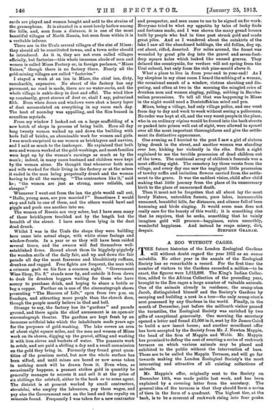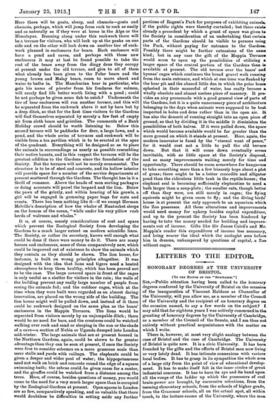A ZOO WITHOUT CAGES.
THE future historian of the London Zoological Gardens will without doubt regard the year 1912 as an annits mirabilis. No other year in the annals of the Zoological Society has so remarkable a record. For the first time the number of visitors to the Gardens exceeded a million—to be exact, the figures were 1,012,898. The King's Indian Collec- tion, added to the African Collection of the preceding year, brought to the Zoo cages a large number of valuable animals. One of the animals already in residence, the orang-utan Jacob, distinguished himself and the Society's Gardens by escaping and building a nest in a tree—the only orang-utan's nest possessed by any Gardens in the world. Finally, in the month of December, just before the millionth visitor passed the turnstiles, the Zoological Society was enriched by two gifts of exceptional generosity. One morning the secretary opened a letter and found £1,000 in it, sent by Sir James Caird to build a new insect house ; and another munificent offer has been accepted by the Society from Mr. J. Newton Mappin, the head of the firm of Mappin and Webb. Mr. Mappin has promised to defray the cost of erecting a series of rockwork terraces on which various animals may be placed and exhibited to the public without the intervention of bars. These are to be called the Mappin Terraces, and will go far towards making the London Zoological Society's the most interesting and attractive of all existing collections of animals.
Mr. Mappin's offer, originally sent to the Society on December 14th, was made public last week, and has been explained by a covering letter from the secretary. The general idea of the terraces is that they should form a series of tiers in the form of a quadrant. The highest tier, at the back, is to be a crescent of rockwork rising into four peaks. Here there will be goats, sheep, and chamois—goats and chamois, perhaps, which will jump from rock to rock as easily and as naturally as if they were at home in the Alps or the Himalayas. Running along under this rockwork there will be a terrace for visitors, who will look up at the peaks on one side and on the other will look down on another tier of rock- work planned in enclosures for bears. Each enclosure will have a pond and caves, and perhaps with these new enclosures it may at last be found possible to take the rest of the bears away from the dingy dens they occupy at present under the old terrace, and give to all of them what already has been given to the Polar bears and the young brown and Malay bears, room to move about and water to bathe in. The Manchurian bear in particular, who gets his name of piscator from his fondness for salmon, will surely find life better worth living with a pond ; could he not perhaps be given some fish to catch? Underneath the tier of bear enclosures will run another terrace, and this will be separated from the rockwork above it not by bars but by a deep ditch, so that for the first time visitors to the Gardens will find themselves separated by merely a few feet of empty air from sloth bears and grizzlies. The comments of a Bank Holiday crowd should be worth listening to. Below this second terrace will be paddocks for deer, a large lawn, and a pond, and the whole series of terraces and rock work will be visible from a tea pavilion which is to be erected at the apex of the quadrant. Everything will be designed so as to place the animals in surroundings as nearly as possible resembling their native haunts, and in this respect the terraces will be the greatest addition to the Gardens since the foundation of the Society. But the terraces will not be merely ornamental. The structure is to be of steel and concrete, and its hollow interior will provide space for a number of the service departments at present scattered through the Gardens. The thought has in it a thrill of romance. Above the heads of men sorting packages or doing accounts will prowl the leopard and the lion. Below the paws of the grizzly, and within hearing of his growls, a girl will be engaged in gumming paper bags for nuts and crusts. There has been nothing like it—if we except Herman Melville's description of how the whaler of Nantucket sleeps on the bosom of the ocean, " while under his very pillow rush herds of walruses and whales."
It is, of course, merely considerations of cost and space which prevent the Zoological Society from developing the Gardens to a much larger extent on modern scientific lines. The Society, or rather its secretary, knows well enough what could be done if there were money to do it. There are many houses and enclosures, some of them comparatively new, which could be improved out of existence to show the animals which they contain as they should be shown. The lion house, for instance, is built on wrong principles altogether. It was designed with the idea that lions and tigers need a heated atmosphere to keep them healthy, which has been proved not to be the case. The large covered space in front of the cages is only useful as a shelter for visitors in the rain; the walls of the building prevent any really large number of people from seeing the animals fed; and the outdoor cages, which at the time when they were built were regarded as an almost daring innovation, are placed on the wrong aide of the building. The lion house might well be pulled down, and instead of it there could be rockwork designed on the same plan as the bears' enclosures in the Mappin Terraces. The lions would be separated from visitors merely by an unjumpable ditch; there would be no need for bars, and the creatures could be watched walking over rock and said or sleeping in the sun or the shade of a cave—a section of Nubia or Uganda dumped into London mid-winter. The large animals that are at present housed in the Northern Gardens, again, could be shown to far greater advantage than they can be seen at present, if once the Society were free to consider schemes on a more generous scale than mere stalls and yards with railings. The elephants could be given a deeper and wider pool of water; the hippopotamuses need not walk on brick and concrete round the edge of a square swimming-bath; the zebras could-be given room for a canter, and the giraffes could be watched from a distance among the trees. Here, of course, besides questions of money, you would come to the need for a very much larger space than is occupied by the Zoological Gardens at present. Open spaces in London are so few, comparatively speaking, and so valuable that there would doubtless be difficulties in setting aside any further portions of Regent's Park for purposes of exhibiting animals, if the public rights were thereby curtailed ; but there exists already a precedent by which a grant of space was given in the Society in consideration of an undertaking that certain parts of the Gardens should be visible to persons using the Park, without paying for entrance to the Gardens. Possibly there might be further extensions of the same kind ; but in any case the gift of the Mappin Terraces would seem to open up the possibilities of utilizing a larger space of the central portion of the Gardens than is available at present. The old terrace over the bears' and hyenas' cages which continues the broad gravel walk running from the main entrance, and which at one time was flanked by the bear pit and the absurd little den in which the polar bears splashed in their saucerful of water, has really become a wholly obsolete and almost useless piece of masonry. It pro- vides an airy promenade with a good general view of parts of the Gardens, but it is a quite unnecessary piece of architecture belonging to the days when animals were supposed to be beat inspected in holes and dens rather than in the open air. It has also the demerit of running straight into an open piece of ground, so that by dividing it in the middle it diminishes the possibilities of both halves. If it were pulled down, the space which would become available would be far greater than the mere ground on which it stands at present. Here, again, the modern innovator is faced by the " eternal want of pence," for it would cost not a little to pull the old terrace down. But that it will come down eventually seems inevitable, with so little space at the Society's disposal, and so many improvements waiting merely for time and opportunity. There should be room somewhere for kangaroos to take something more than a few leisurely hops about a plot of grass; there ought to be a better crocodile and alligator pond than the ridiculous little tank in the reptile-house ; the elephant seal is becoming sufficiently elephantine to need a bath larger than a soup-plate ; the smaller cats, though better off than they were, are still merely in cages ; the flying squirrels might be given room to fly; and the diving birds* house is at present the only approach to an aquarium which the Zoo possesses. All these alterations and improvements would need money for upkeep besides capital expenditure, and up to the present the Society has been hindered by having to take the money needed for building and improve- ments out of income. Gifts like Sir James Caird's and Mr. Mappin's render this expenditure of income less necessary, and bring nearer the ideal which the zoologist sees before him in dreams, unhampered by questions of capital, a Zoo without cages.



























































 Previous page
Previous page